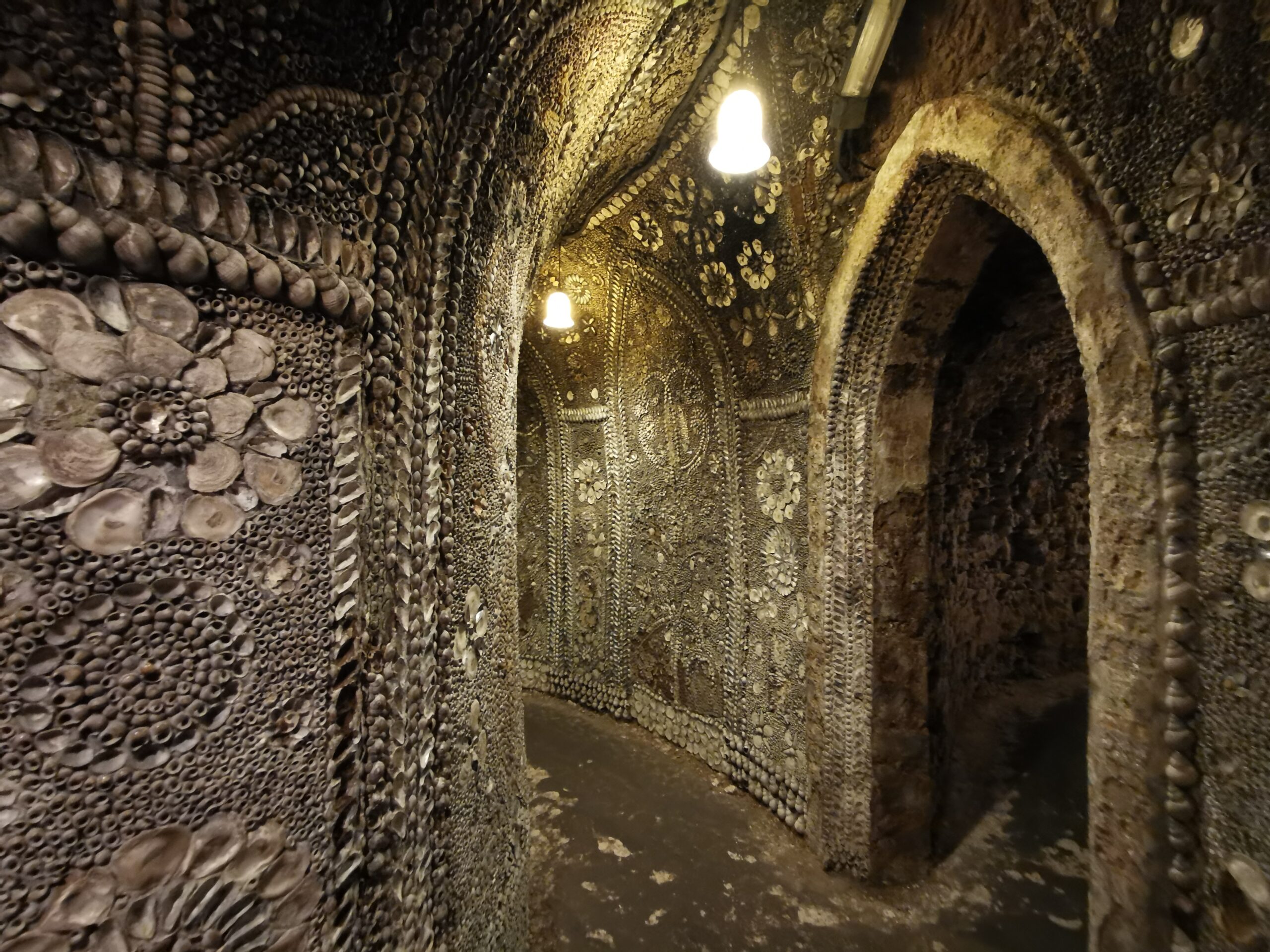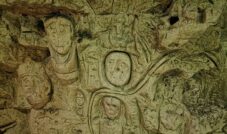Verdict: The Margate shell grotto is unlike anything else I’ve seen so it’s definitely worth visiting. Pictures don’t really do it justice, it’s only when you’re inside you appreciate just how many shells were used and the love and labour that went into the displays.
What is the Margate Shell Grotto?
The Margate Shell Grotto, contains a winding subterranean passageway. Measuring roughly 8 feet (2.4 meters) high and 70 feet (21 meters) long, it leads to a rectangular chamber called the Altar Room. This room, about 15 by 20 feet (5 by 6 meters), features an archway connecting it to a rotunda. At the centre of the rotunda, a domed ceiling rises to the surface, allowing natural daylight to filter through. It’s estimated to contain 4.6 million shells in the patterns depicting suns, animals, flowers, trees. The shells have been identified as cockles, limpets, oysters, mussels and Queen conch which is not native to British waters.
How was the Shell Grotto in Margate discovered?
There are several stories as to how the Shell Grotto was discovered and when. Most sources say it was discovered in 1835 by James Newlove, a local resident.
Another story suggests a farm worker discovered the shell grotto digging the isolated field. Interestingly, there are no historical records of a great house or castle in that area where underground grottos where generally built in 18th century Europe (a fad at the time). The local schoolmaster bought the farm land, believing he could turn the grotto into a tourist attraction. Even in 1837, Margate was a popular seaside resort.
Shell grottos gained popularity in the mid-18th century, and the arrangement of shells in this structure reflects architectural styles of the time, such as fielded panelling and gothic arches and ogees.
Others believe the patterns have possible Buddhist connections or possibly connected to the worship of a Greek or Roman sea god.
Marie Corelli in 1885 called Margate Shell Grotto one of the wonders of the world but was badly named, badly advertised and that Margate was over-popular. Alternative names should be The Shell Tomb of the Vikings, The Norsemen’s Cave or The Scandinavian Shell Temple based on her beliefs of its origins. Sixpence seemed a small sum to such a beautiful and extraordinary place. Some people would even try to pick the shells out of the walls.
Some scientists and archaeologists believe the grotto dates back 3,000 years, while others propose connections to Mexican culture or suggest it might be as old as 12,000 years.
Other theories surrounding its creation include Pagan religious rites, ties to the Knights Templar, astrological calendars, or the eccentric retreat of a wealthy individual. In the 1930s, spiritualists even conducted séances there, although their findings were never documented.
Or maybe it has Roman connections from the first four centuries AD, when Britain was part of the Roman Empire or the Bronze age or even earlier
Others linked to the Shell Grotto to Phoenicians and Romans. It resembles an underground excavation, possibly used for flint extraction.
The Shell Grotto’s layout could hold the key. Its a serpentine passage that descends and coils around a central rotunda, ending in a rectangular altar room. It is said to reflect the architectural style of temples like Dashwood’s Hellfire Caves and Delphi’s Oracles, with symbolic references to a birth canal. Unique features such as depictions of a womb, an umbilical cord, and symbolic phallus forms add to its intricate symbolism, including its alignment with the midday sun in May.
During the summer solstice, sunlight passes through the dome of the grotto and illuminates the entire tunnel. Based on this observation, researchers deduced that the grotto was constructed approximately in the year 1141. The accuracy of this estimate relies on the gradual one percent change in the equinox angle, which occurs over a span of seventy-two years.
Or maybe it has spiritual connections, based on the design to hold a lamp or candle as symbolic of the cave of the sun. According to “Morien,” such grottos represent the ocean’s margin and the soul of the sun, connecting celestial and terrestrial imagery.
Modern dating methods have proven ineffective for the Margate Shell Grotto. The chalk walls, covered in mortar and shell mosaics, are coated with residue from gas flames used during its initial public opening, rendering carbon dating unusable.
Physic Richard J West investigated and suggests have begun as a medieval Denehole, later repurposed into its current shell-adorned form by the Newlove family. Fanny and Joshua Newlove, despite claims of its accidental discovery in 1835, were reportedly aware of its existence much earlier. Their father, Newlove, employed local tradesmen starting in 1826 to transform the site into a Victorian “folly,” a decorative pastime popular among the wealthy. This process took over four years, and the grotto was eventually sealed, with shell mosaics placed over its construction entrance. Due to financial difficulties, Newlove introduced the site as a tourist attraction, perpetuating the myth of its ancient origins.
Although Grotto Day (July 25th) continues as a lesser summer holiday in England, Margate Shell Grotto was identified with the day. Continued today, Margate Shell Grotto sponsors a Grotto Day celebration with shell oriented crafts for children.
Photos of Margate’s Shell Grotto
Someone really liked shells, huh?
This must have taken them aaaaaages. Some of the shells are tiny too.
I’ve read several sources and compiled all of the history and theories.
The grotto was discovered by chance in 1835. If that was me, I would have said ‘NOPE’, sealed it up for good and walked away.
It’s definitely haunted. It has this ‘culty’ aura about it. Or maybe I’ve watched too much Buzzfeed Unsolved.
I was worried about looking at my photos straightaway after taking them if I’m being honest. I was convinced I’d see a full body apparition or an orb.
In all seriousness, the shell grotto is beautiful and a work of art. I’d recommend following the guide that you are given upon entry as it has information on the different displays thorughout. It was fun staring into the shells like an optical illusion until you finally could see the pattern which matched the name on the guide.
The Margate Shell Grotto is just a ten minute walk from the Turner Contemporary and I’d say touring the Shell Grotto takes around 30 mins. People have been paying to visit since 1838 and you should too.
See the latest entry prices for Margate Shell Grotto here
Address:
33 Grotto Hill,
Cliftonville,
Margate,
CT9 2BU
20 minute walk from Margate train station









You might also be interested in…
- Best Things To Do In Margate
- Best Places To Eat In Margate
- Best Coffee Places In Margate
- Insta-damn! Best Places To Eat And Shop in Broadstairs
What’s to visit nearby?
Citations and Further Reading
Marsh, P. J. (2020). The Enigma of the Margate Shell Grotto: An Examination of the Theories on Its Origins. United Kingdom: Martyrs Field Publications.
Fanthorpe, R. L., Fanthorpe, P. (1999). The World’s Most Mysterious Places. United States: Dundurn Press.
Hobson, M. (2025). The Wonder of Seashells: Discover the Meaning and Magic of the Ocean’s Treasures. United States: Wellfleet Press.
Mutton, K. (2020). Subterranean Realms: Subterranean & Rock Cut Structures in Ancient & Medieval Times. (n.p.): Adventures Unlimited Press.
West, R. J. (2014). The Reluctant Psychic: More Case Files. United Kingdom: AuthorHouse UK.
Laoutaris, C. (2008). Shakespearean Maternities: Crises of Conception in Early Modern England. United Kingdom: Edinburgh University Press.
Fanthorpe, P. (2005). The World’s Most Mysterious Castles. Canada: Dundurn Press.
Littell’s Living Age. (1885). United States: T.H. Carter & Company.
Elborough, T. (2024). Atlas of Unexpected Places: Haphazard Discoveries, Chance Places and Unimaginable Destinations. United Kingdom: Aurum.
Spence, K. (1999). The Companion Guide to Kent and Sussex. United Kingdom: Companion Guides.
Bull, A. (2019). Secret Margate. United Kingdom: Amberley Publishing.
Sharp, A. (2020). The English Heretic Collection: Ritual Histories, Magickal Geography. United States: Watkins Media.
Edmond, R. (2023). Borderland. United Kingdom: Troubador Publishing Limited.
Abdill, E. (2015). Masters of Wisdom: The Mahatmas, Their Letters, and the Path. United States: Penguin Publishing Group.
The Witches’ Almanac: Issue 36, Spring 2017 to 2018: Water: Our Primal Source. (2016). Cameroon: Witches’ Almanac.
Barker, N., Brodie, A., Dermott, N., Jessop, L., Winter, G. (2015). Margate’s Seaside Heritage. United Kingdom: Historic England.
Bayley, H. (2022). Archaic England: An Essay in Deciphering Prehistory from Megalithic Monuments, Earthworks, Customs, Coins, Place-names, and Faerie Superstitions. Czechia: DigiCat.
Melton, J. G. (2011). Religious Celebrations: An Encyclopedia of Holidays, Festivals, Solemn Observances, and Spiritual Commemorations. Ukraine: ABC-CLIO.
The Banner of Israel. (1896). United Kingdom: William Cookson, Jun..
West, R. J. (2014). The Reluctant Psychic: More Case Files. United Kingdom: AuthorHouse UK.










